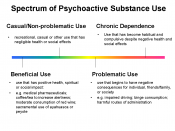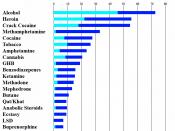Drug abuse trends within the United States is constantly evolving but the one fact that continues to remain consistent is its prominent position as a public health concern that influences society on numerous levels. Substance abuse does not discriminate based on location, social stature, annual income, or race. This problem has proven to be an epidemic and its roots are profound. This paper will cover the past and current trends of the use and abuse of substances in the United States, ways in which American culture encourages and supports drug use and abuse, the cultural appropriateness of using narcotics for medicinal purposes, and the health problems directly resulting from drug use and abuse.
The induction of substance abuse began long before the 1900s. "The European explorers from Columbus on found other [in addition to alcohol] mind-affecting drugs, and brought them with them. Tobacco was discovered on Columbus' first voyage. Cocaine was found in large areas of South America.
Caffeine and LSD-like drugs were found scattered all over the world ... the Europeans not only adopted nicotine and caffeine but spread them everywhere. They also imported opium. In a remarkably short space of time, western Europe was converted from an alcohol-only culture to a multi-drug culture" (Brecher, 1972). The American Indians introduced tobacco use to the Europeans prompting sailors to mimic the practice and eventually transported this substance to England.
"In 1575, the Catholic Church in Mexico passed a regulation forbidding smoking in church. In 1642 and 1650, Papal edicts against the use of tobacco were issued. The European states, Constantinople, Japan, and Russia all had anti-tobacco laws, but the practice continued against all opposition. Russia's Czar Michael Feodorovitch, first of the Romanoffs, in 1634 pronounced a penalty that tends toward overkill: "'Offenders are usually sentenced to slitting of the nostrils,


